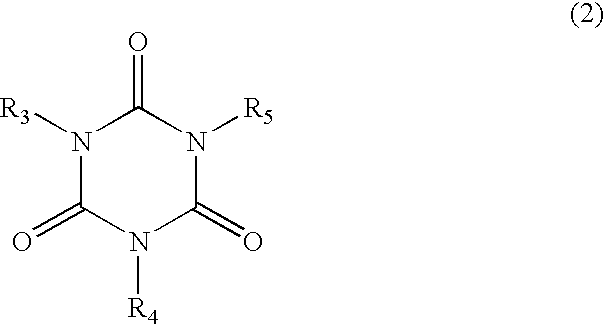Anti-Reflective Coating Forming Composition Containing Vinyl Ether Compound
a technology of anti-reflective coating and vinyl ether, which is applied in the direction of photosensitive materials, instruments, photomechanical equipment, etc., can solve the problems of reducing the dimension accuracy of the photoresist pattern, serious problems, and difficulty in ensuring the film thickness of the photoresist required for substrate processing
- Summary
- Abstract
- Description
- Claims
- Application Information
AI Technical Summary
Benefits of technology
Problems solved by technology
Method used
Image
Examples
example 1
Synthesis of Alkali-Soluble Compound
[0101]In 118 g of cyclohexanone, 19.0 g of 3,7-dihydroxy-2-naphthoic acid, 10 g of tris(2,3-epoxypropyl)isocyanurate, and 0.552 g of benzyltriethyl ammonium chloride were reacted at 130° C. for 24 hours to obtain solution [a] containing alkali-soluble compound (compound of formula (36)).
(Preparation of Anti-Reflective Coating Forming Composition)
[0102]To 14.0 g of the solution [a], 1.40 g of tris(4-vinyloxy)butyltrimellitate, 0.105 g of triphenylsulfoniumtrifluoromethane sulfonate, 52.3 g of propylene glycol monomethyl ether and 67.5 g of propylene glycol monomethyl ether acetate were added, and stirred at room temperature for 30 minutes to prepare anti-reflective coating forming composition solution [1].
(Evaluation of Anti-Reflective Coating Forming Composition)
[0103]The anti-reflective coating forming composition solution [1] was coated on a semiconductor substrate (silicon wafer) using a spinner and the substrate was heated at 170° C. for 1 min...
example 2
Synthesis of Alkali-Soluble Compound
[0105]In 155 g of N-methylpyrrolidone, 3.80 g of 3,5-diaminobenzoic acid, 9.06 g of 2,2-bis(3-amino-4-toluoyl)hexafluoropropane, and 9.51 g of 1,2,3,4-cyclobutane tetracarboxylic acid dianhydride were added and then reacted at room temperature for 24 hours. N-methylpyrrolidone was added to dilute in a concentration of 8.0 mass %, and then acetic anhydride and pyridine were added, and dehydration-ring closure reaction was carried out at 40° C. for 2 hours. The resulting solution was poured in water, filtered off and dried to obtain polyimide (formula (54), p1: 50%, p2: 50%) as powder. The resulting polyimide had a weight average molecular weight of 28000 (in terms of standard polystyrene).
The polyimide was dissolved in propylene glycol monomethyl ether in a concentration of 30 mass % to obtain solution [b] containing alkali-soluble compound.
(Preparation of Anti-Reflective Coating Forming Composition)
[0106]To 10.0 g of the solution [b], 6.50 g of tr...
example 3
Synthesis of Alkali-Soluble Compound
[0109]In 45.5 g of propylene glycol monomethyl ether, 3.60 g of methyl methacrylate, 6.37 g of N-(4-hydroxyphenyl)methacrylamide, 5.00 g of mono-2-(methacryloyloxy)ethylphthalate, 0.30 g of N,N′-azobisisobutyronitrile and 0.34 g of dodecane thiol were added and then reacted at 70° C. for 20 hours to obtain a solution containing an alkali-soluble compound (polymer of formula (48), q1: 40%, q2: 40%, q3: 20%). This solution was added in diethyl ether, and the resulting precipitate was washed with diethyl ether twice times to obtain a polymer as white solid. The resulting polymer had a weight average molecular weight of 8700 (in terms of standard polystyrene). This polymer was dissolved in propylene glycol monomethyl ether to obtain solution [c] having 20 mass %.
(Preparation of Anti-Reflective Coating Forming Composition)
[0110]To 12.0 g of the solution [c], 120 g of propylene glycol monomethyl ether, 0.60 g of tris(4-vinyloxy)butyltrimellitate and 0.0...
PUM
| Property | Measurement | Unit |
|---|---|---|
| wavelength | aaaaa | aaaaa |
| wavelength | aaaaa | aaaaa |
| temperature | aaaaa | aaaaa |
Abstract
Description
Claims
Application Information
 Login to View More
Login to View More - R&D
- Intellectual Property
- Life Sciences
- Materials
- Tech Scout
- Unparalleled Data Quality
- Higher Quality Content
- 60% Fewer Hallucinations
Browse by: Latest US Patents, China's latest patents, Technical Efficacy Thesaurus, Application Domain, Technology Topic, Popular Technical Reports.
© 2025 PatSnap. All rights reserved.Legal|Privacy policy|Modern Slavery Act Transparency Statement|Sitemap|About US| Contact US: help@patsnap.com



